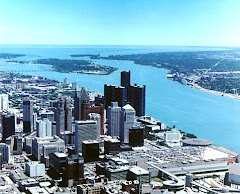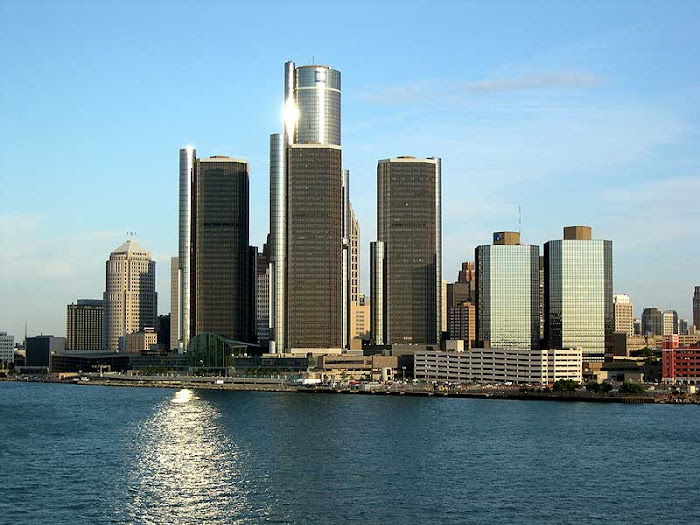
The Fisher Building (1928) is an ornate skyscraper in the New Center area of Detroit, Michigan constructed of limestone, granite, and marble. Its roof was once adorned in gold which was removed for the air raid black outs during World War II. Designated a National Historic Landmark on June 29, 1989, the building was designed to house the automotive company Fisher Body of the Fisher brothers (Frederick, Charles, William, Lawrence, Edward, Alfred and Howard).
Standing on the corner of West Grand Boulevard and Second Avenue in Detroit, Michigan, the Art Deco skyscraper lies in the heart of the New Center area of Detroit. The office building rises 30-stories with a roof height of 428 ft (130.5 m), a top floor height of 339 ft (103.6 m), and the spire reaching 444 ft (135 m). The building has 21 elevators. Designed by Albert Kahn and Associates with Joseph Nathaniel French as chief architect, it has been called Detroit's largest art object. and is widely considered Kahn's greatest achievement. The year of its construction, the Fisher building was honored by the Architectural League of New York as the year's most beautiful commercial structure. The opulent three-story barrel vaulted lobby is constructed with forty different kinds of marble, decorated by Hungarian artist Géza Maróti, and is highly regarded by architects.
Initially, Kahn planned for a complex of three buildings, with two 30-story structures flanking a third tower twice that height. However, the Great Depression kept the project at one tower.
The Fisher brothers constructed the building across from the General Motors Building (Now Cadillac Place). General Motors had recently purchased the Fisher Body Company. The two massive buildings spurred the development of a New Center for the city, a business district north of its downtown area.
Radio
The top of the building was gilt and topped with a radio antenna. One of the building's oldest tenants is radio station WJR, whose broadcasters often mention that their signals are broadcast "from the golden tower of the Fisher Building." Two other radio stations, WDVD-FM and WDRQ-FM, also broadcast from the building. On St. Patrick's Day, the golden tower is lit up with green light to celebrate the holiday instead of the traditional orange color. In recent years, to celebrate the NHL playoffs, the tower is lit with red light in honor of the Detroit Red Wings.
Theatre
The building also is home to the Fisher Theatre, one of Detroit's oldest live theatre venues. The theatre originally featured a lavish Aztec-themed interior in the Mayan Revival style, and once had Mexican-Indian art and banana trees and live macaws that its patrons could feed. After the Depression, the theatre operated primarily as a movie house until 1961. Originally with 3,500 seats, the interior was renovated with a 2,089-seat theatre that allowed for more spacious seating for patrons. The decor was changed to a more simple mid-century design (which some feel is now far more "dated" in appearance than the grandiose art deco foyer). The Fisher Theatre is owned and operated by the Nederlander Organization and now primarily features travelling productions of Broadway shows.
Art
Befitting to the Fisher Building's history in association with art, there have been three nationally recognized Fine Art Galleries that have been located in the structure including the Gertrude Kasle Gallery and London Fine Arts Group.
Gertrude Kasle Gallery: Located in Suite 310 of the Fisher Building from 1965-1976 was a nationally recognized Fine Art Gallery hosting exhibits for some of the most highly respected artists of the second half of the 20th century including Willem de Kooning, Jim Dine, Helen Frankenthaler, Robert Goodnough, Adolph Gottlieb, Phillip Guston, Grace Hartigan, Ian Hornak, Ray Johnson, Robert Motherwell, Lowell Nesbitt, Claes Oldenburg, Robert Rauschenberg and Jack Tworkov.
London Arts Group: Located in a large portion of the third floor of the Fisher Building during the 1970’s and 1980’s, London Fine Arts Group acted as an internationally recognized publishing company assisting in producing limited edition art works for many internationally recognized artists including Yaacov Agam, Karel Appel, Arman, Romare Bearden, Gene Davis, Don Eddy, Alberto Giacometti, Ian Hornak, Lester Johnson,Alex Katz, Richard Lindner, Roberto Matta, Lowell Nesbitt, Robert Rauschenberg, Donald Sultan, Victor Vasarely and Larry Zox.
Standing on the corner of West Grand Boulevard and Second Avenue in Detroit, Michigan, the Art Deco skyscraper lies in the heart of the New Center area of Detroit. The office building rises 30-stories with a roof height of 428 ft (130.5 m), a top floor height of 339 ft (103.6 m), and the spire reaching 444 ft (135 m). The building has 21 elevators. Designed by Albert Kahn and Associates with Joseph Nathaniel French as chief architect, it has been called Detroit's largest art object. and is widely considered Kahn's greatest achievement. The year of its construction, the Fisher building was honored by the Architectural League of New York as the year's most beautiful commercial structure. The opulent three-story barrel vaulted lobby is constructed with forty different kinds of marble, decorated by Hungarian artist Géza Maróti, and is highly regarded by architects.
Initially, Kahn planned for a complex of three buildings, with two 30-story structures flanking a third tower twice that height. However, the Great Depression kept the project at one tower.
The Fisher brothers constructed the building across from the General Motors Building (Now Cadillac Place). General Motors had recently purchased the Fisher Body Company. The two massive buildings spurred the development of a New Center for the city, a business district north of its downtown area.
Radio
The top of the building was gilt and topped with a radio antenna. One of the building's oldest tenants is radio station WJR, whose broadcasters often mention that their signals are broadcast "from the golden tower of the Fisher Building." Two other radio stations, WDVD-FM and WDRQ-FM, also broadcast from the building. On St. Patrick's Day, the golden tower is lit up with green light to celebrate the holiday instead of the traditional orange color. In recent years, to celebrate the NHL playoffs, the tower is lit with red light in honor of the Detroit Red Wings.
Theatre
The building also is home to the Fisher Theatre, one of Detroit's oldest live theatre venues. The theatre originally featured a lavish Aztec-themed interior in the Mayan Revival style, and once had Mexican-Indian art and banana trees and live macaws that its patrons could feed. After the Depression, the theatre operated primarily as a movie house until 1961. Originally with 3,500 seats, the interior was renovated with a 2,089-seat theatre that allowed for more spacious seating for patrons. The decor was changed to a more simple mid-century design (which some feel is now far more "dated" in appearance than the grandiose art deco foyer). The Fisher Theatre is owned and operated by the Nederlander Organization and now primarily features travelling productions of Broadway shows.
Art
Befitting to the Fisher Building's history in association with art, there have been three nationally recognized Fine Art Galleries that have been located in the structure including the Gertrude Kasle Gallery and London Fine Arts Group.
Gertrude Kasle Gallery: Located in Suite 310 of the Fisher Building from 1965-1976 was a nationally recognized Fine Art Gallery hosting exhibits for some of the most highly respected artists of the second half of the 20th century including Willem de Kooning, Jim Dine, Helen Frankenthaler, Robert Goodnough, Adolph Gottlieb, Phillip Guston, Grace Hartigan, Ian Hornak, Ray Johnson, Robert Motherwell, Lowell Nesbitt, Claes Oldenburg, Robert Rauschenberg and Jack Tworkov.
London Arts Group: Located in a large portion of the third floor of the Fisher Building during the 1970’s and 1980’s, London Fine Arts Group acted as an internationally recognized publishing company assisting in producing limited edition art works for many internationally recognized artists including Yaacov Agam, Karel Appel, Arman, Romare Bearden, Gene Davis, Don Eddy, Alberto Giacometti, Ian Hornak, Lester Johnson,Alex Katz, Richard Lindner, Roberto Matta, Lowell Nesbitt, Robert Rauschenberg, Donald Sultan, Victor Vasarely and Larry Zox.








No comments:
Post a Comment